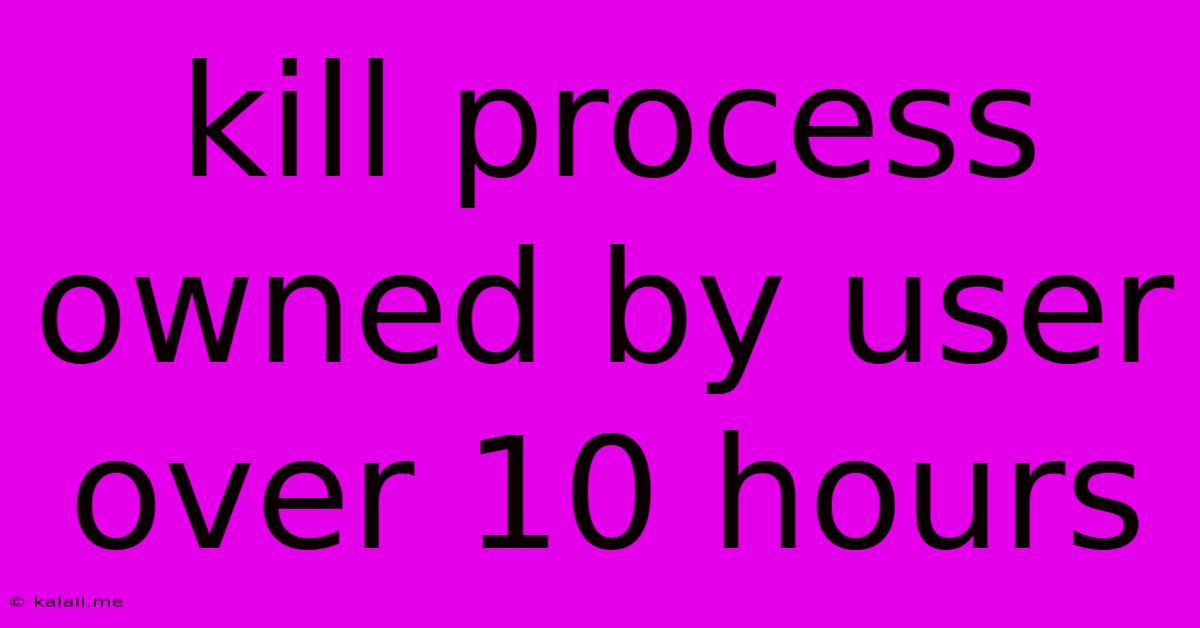Kill Process Owned By User Over 10 Hours
Kalali
May 24, 2025 · 3 min read

Table of Contents
Killing Processes Owned by a User Older Than 10 Hours: A Comprehensive Guide
This article provides a detailed guide on how to identify and terminate processes owned by a specific user that have been running for over 10 hours. This is crucial for system administration, troubleshooting resource hogs, and maintaining system stability. We'll explore various methods using command-line tools, focusing on Linux and macOS systems, which are commonly used in server environments and development.
Understanding the Problem: Long-running processes, especially those consuming excessive resources like CPU or memory, can significantly impact system performance. Identifying and terminating these processes, particularly those owned by a specific user, is essential for proactive system maintenance. This is especially true for processes that might be malfunctioning or exhibiting unexpected behavior.
Identifying Long-Running Processes:
The first step involves identifying processes that have been running for more than 10 hours. We'll use the ps command, a powerful tool for viewing process information.
1. Using ps and awk:
This approach combines the ps command with awk to filter processes based on their age and owner. Replace <username> with the actual username you're targeting.
ps -eo pid,ppid,cmd,%cpu,%mem,etime,uid --sort=-etime | awk -v user="" '$7 == user && $6 > "10:00:00" {print $0}'
ps -eo pid,ppid,cmd,%cpu,%mem,etime,uid: This part of the command displays the process ID (PID), parent process ID (PPID), command, CPU usage, memory usage, elapsed time, and user ID (UID).--sort=-etime: This sorts the output by elapsed time in descending order (newest first).awk -v user="<username>" '$7 == user && $6 > "10:00:00" {print $0}': This filters the output, selecting only processes owned by<username>($7 == user) that have been running for more than 10 hours ($6 > "10:00:00").
2. Using top and manual observation:
The top command provides a dynamic view of running processes. While it doesn't directly filter by age, you can manually identify long-running processes owned by a specific user by observing the "TIME+" column and the "USER" column. Press Shift + P to sort by process age and manually scan for processes owned by the user in question. Note that this method requires manual observation and is less precise.
Terminating Processes:
Once you've identified the problematic processes, you can terminate them using the kill command.
1. Using kill with PID:
The most straightforward method involves using the process ID (PID) obtained from the ps command.
kill
Replace <PID> with the actual process ID. This sends a SIGTERM signal, requesting the process to terminate gracefully.
2. Using kill with SIGKILL (force kill):
If a process doesn't respond to SIGTERM, you can use SIGKILL to forcefully terminate it. This is generally a last resort as it can lead to data loss if the process wasn't saving its work properly.
kill -9
Important Considerations:
- Resource Consumption: Before killing a process, observe its resource usage (CPU and memory). A high CPU or memory usage is a strong indicator that the process might be causing performance issues.
- Process Importance: Be cautious when killing processes, especially system processes. Incorrectly terminating a critical process can cause system instability.
- Logging: It's crucial to log the process IDs and user information before and after termination for auditing and troubleshooting purposes.
- Alternative Approaches: For more sophisticated monitoring and management of long-running processes, consider using system monitoring tools like
htop,systemd, or specialized monitoring software.
By combining the techniques described above, you can effectively manage long-running processes owned by a specific user, ensuring the stability and performance of your system. Remember to always exercise caution and understand the potential implications before terminating any process.
Latest Posts
Latest Posts
-
How Many Tenths Are In An Inch
Jul 15, 2025
-
Which Word Has The Most Positive Connotation
Jul 15, 2025
-
How Do I Send An Evite Reminder
Jul 15, 2025
-
When Performing A Self Rescue When Should You Swim To Shore
Jul 15, 2025
-
How Many Decaliters Are In A Liter
Jul 15, 2025
Related Post
Thank you for visiting our website which covers about Kill Process Owned By User Over 10 Hours . We hope the information provided has been useful to you. Feel free to contact us if you have any questions or need further assistance. See you next time and don't miss to bookmark.